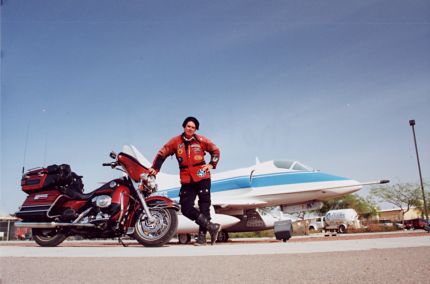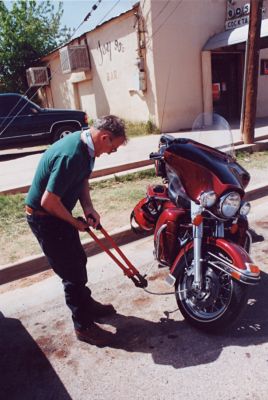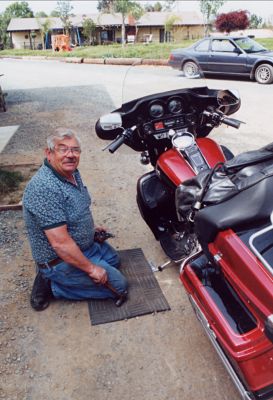|
|||
|
Returning to America after seven months on the road around the globe was a combination of positive and negative. The positives were the comfortable feeling of availability of nearly anything I wanted, from food to cheap gas. The negatives were landing in Los Angeles during rush hour traffic. The motorcycle I was to use on this last leg of my ride around the world was a 2001 Harley-Davidson FLHTCU/I Ultra Classic Electra Glide. Weighing in at 834 pounds it is by far the heaviest motorcycle I used, heavier even than the AMAZONAS with a Volkswagen engine and transmission. At $20,360.00 USD it was also the most expensive.
No rocket, the Harley-Davidson had about as much acceleration as my Indian Enfield Bullet away from stoplights. Where it did excel was in the goodies department, like fuel injection, disc brakes (front and back), cruise control, AM/FM radio and tape player, full fairing and a plush seat that made 600-mile days easy. | |||
|
Because the weather reports showed snow and rain around my home in Montana (one of the reasons I leave for points around and below the equator each fall), I decided to roam around the Southwest before ending my ride around the world. Route 66, known as the "Mother Road" of America was calling and I had the motorcycle to answer that call. The parts of Route 66 I like best are those in Arizona and New Mexico. After Route 66 hits Texas and turns north through Oklahoma it gets pretty boring, but sections in the southwest can give you a real taste of 50 years ago. Gas stations where an attendant pumps the gas, old "mom and pop" motels, diners serving blue plate specials and donkeys walking down the middle of the street, they are all on the more interesting sections of Route 66.
Some sections of Route 66 are "lost," meaning the original road has been torn up or covered over, no longer in use. Other sections are just dirt roads running parallel to Interstate 40. I found that while the Harley would take these sections of gravel and loose sand, like the photo above shows, it did not like them, meaning it is no dual-purpose motorcycle. | |||
|
I decided to vector further south in Arizona, right down to the Mexican border. I went in a short way, then re-entered the USA and started working my way back north. It was springtime in the deserts along the border, with cactus in bloom from earlier spring showers. In southern Arizona I was treated to some of the best motorcycling I had on the entire ride around the world. Great roads, little traffic, tee-shirt weather and the stereo sounds of country and western or oldie rock 'n roll music blasting from the Harley sound system. When I ran out of music I would listen to the 1450cc V-twin. It was a super sound, a sound born and bred in America. No other motorcycle in the world has that sound. Some come close, like anything with an S&S motor, but Harley is special. Maybe that is one of the reasons they are so popular. I liked the sound of it, even with all of the original baffling. I screwed up one afternoon and left the keys to my security chain 20 miles away in my bedroom. I locked the Harley with it's own ignition/fork lock, then for an extra measure I passed my security chain through the front wheel and crash bars, closing the lock before I checked to see if the key was in my pocket. At the sound of the lock clicking shut I knew it was not. According to the advertising for the chain I was up the dark creek with no paddle. The only way the Harley was going to go anywhere was if about ten gorillas picked it up, or so I thought.
Phillip Orth, one of my riding friends from Sierra Vista, Arizona, was traveling with me the day I screwed up. Phillip is either pretty smart or has had some experience in liberating locked-up Harley-Davidsons. He went across the street to a car repair shop and borrowed a pair of bolt cutters. In less time than it took to drink a Coke the security chain was cut. I had carried that chain with me for the past seven months, often using it to secure my motorcycles to immovable objects for security purposes. Phillip showed me how silly that had been. In the picture above you can see how "at home" Phillip was with the Harley liberating tool. The Harley-Davidson was a fine motorcycle for running the super slabs, what we in America call our multi-lane interstates or autobahns. I could cruise at 75 miles per hour, hour after hour. The gas tank, holding 5 gallons of gas, was a little small for this speed, because I had to stop every 150 miles for a refill. Once I managed 170 miles but that left only 2/10ths of a gallon. One thing that I noticed was I now belonged to the "Harley Club." Other Harley-Davidson riders would wave at me from the opposite direction as we passed. Often this is not the case when I am riding one of my other motorcycles, especially if it is something like my Yamaha XT or one of my sport bikes. But when I was on the big Ultra Classic it was like I had started wearing deodorant or brushing my teeth, people were waving at me. I am not normally a big wave type of rider. If someone waves at me, I will usually wave back. I seldom initiate the exercise. I can not think of anyone waving at me as I crossed India or Nepal. In part that is because you ride on the other side of the road in those countries, meaning the left lane, so waving means taking your hand off the throttle to do so, which closes the throttle and slows you down. But in the USA there seems to be a need for some riders to wave, maybe to say to the other rider, "Hey, brother, you and I are connected. Both of us out here riding our motorcycles on the same road." Some riders wave at anything coming their way, others are more selective and wave only at those riding the same type of motorcycles. With the Harley I was definitely getting the high sign and wave from a lot of other Harley riders who would have probably cringed if they knew I had just stepped off a 125-cc step through SYM in Taiwan. I felt like I was a spy, looking into another world, as I cruised the highway system with other members of the Club, getting the wave all day. | |||
|
The photo above shows what the Harley-Davidson definitely did not like, sand. On the pavement the Ultra had the directional stability of a guided missile. In the sand the 16-inch Dunlop tires made it wallow around like a drunken fat lady. If it fell over it would take at least two people to lift it upright, and I was traveling alone, so when I hit the sand in this desert I turned around and went back to the pavement. Both the Harley and I were much happier on macadam than spending a couple of hours in the hot sun waiting for someone to come along and help me pick the fat lady up. The Harley did let me down one day. It had a heel/toe shifter and the toe portion stripped itself making it useless. I could still use the heel part to get it through the gears but the front part flopped around. This happened near Riverside, California and the nearest place I could think of or find was an Indian Motorcycle shop. Not the "new" Indian motorcycles, but a shop that specializes in the real Indians, pre-1954 motorcycles, the Kiwi Indian Parts Company. The owner, Mike Tomas, and his longtime Parts Manager Steve Adams, were a bit surprised to see me ride into their parking lot on a Harley-Davidson, both knowing I was on my third ride around the world and thinking I was still somewhere in Asia. I asked them if I could borrow a couple of wrenches to fix the shifter, but before I could start taking it apart I was pushed aside by their Workshop Manager Joe Lambert. Joe, who owns a 1994 Ultra Classic, and was a Harley mechanic for a city police department until he retired, knew exactly what to do. He reversed the heel and toe parts and I was happily shifting my way out of their parking lot an hour later. The labor bill for repairing a Harley-Davidson in an Indian Motorcycle shop? "Free, no charge, you are welcome, and have a cup of free coffee too." They are some nice people at the Kiwi Indian Parts. I can name a lot of places where that quick fix would have set me back $100.00 USD.
In the photo above you can see Joe Lambert as he finished up the repair in my shifter. Notice in his right hand the hammer. Another "round the world" traveler and friend of mine, Dave Barr, said that the most useful tool he took with him when he rode his Harley-Davidson 83,000 miles around the world was a hammer. I had not carried one once on this trip. The first Harley that I used needed a hammer. I guess some things never change. As soon as the weather breaks in the Rocky Mountains I will return home. In the meantime I will wander some more roads with the Harley-Davidson. It feels at home here in America, on American roads, using American gas and oil. To ride it makes me feel as if it has a soul, so purely American it is. The Enfield I used in India came close to feeling that way, a machine with a heart. The BMW I used across the European continent felt just like a machine. The Hartford, Honda, SYM and AMAZONAS were interesting sets of two wheels, but again just machines. The only other motorcycle that I have used on this trip whose relationship with me was one of a soul mate was the 1947 Indian Chief I started this global ride with. While the Indian Motorcycle Company went out of business in the 1950's, the Indian still has its soul. It's nice to see that the Harley-Davidson Company has found a way to build soul into their modern day motorcycles. I like soul in a bike. | |||
|
| |||
|
| ||
|
Copyright © Dr. Gregory W. Frazier 1999- All Rights Reserved.
Thoughts and opinions expressed here are those of the author, and not necessarily Horizons Unlimited
|




